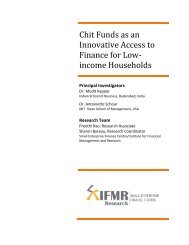Government of India Volume I: Analysis and Recommendations
Government of India Volume I: Analysis and Recommendations
Government of India Volume I: Analysis and Recommendations
Create successful ePaper yourself
Turn your PDF publications into a flip-book with our unique Google optimized e-Paper software.
FUNCTIONS AND POWERS OF THE REGULATOR<br />
Table <strong>of</strong> <strong>Recommendations</strong> 4.9 Investigations<br />
The Commission recommends that investigations should be:<br />
◮ Carried out according to the written terms <strong>of</strong> investigation;<br />
◮ Carried out by an appointed investigator;<br />
◮ Finished within a time bound manner, unless extended by an administrative law <strong>of</strong>ficer; <strong>and</strong><br />
◮ Carried out with least disruption to the function or reputation <strong>of</strong> a business.<br />
The investigators empowered under the draft Code should have the power to:<br />
1. Require production <strong>of</strong> documents;<br />
2. Require persons to answer questions;<br />
3. Require co-operation <strong>of</strong> non-regulated entities in investigation; <strong>and</strong><br />
4. Require co-operation from other government agencies.<br />
Table <strong>of</strong> <strong>Recommendations</strong> 4.10 Information-sharing between regulators<br />
1. The draft Code should require the regulator to create a framework for sharing <strong>of</strong> information.<br />
2. The electronic information framework <strong>of</strong> each regulator should be compatible with that <strong>of</strong> other regulator(s)<br />
<strong>and</strong> agencies with which it regularly shares information.<br />
3. The legal framework should have adequate checks <strong>and</strong> records to prevent misuse <strong>of</strong> informations.<br />
1. A confidential manner so as to prevent panic before any finding; <strong>and</strong><br />
2. A time bound manner so as not to unduly burden the entity under investigation.<br />
4.2.4. Sharing <strong>of</strong> information<br />
Investigations are greatly assisted by a strong database providing details <strong>of</strong> the regulated<br />
entities <strong>and</strong> the transactions they have undertaken. The Commission recognises that this<br />
information may not be available at a single source. Hence, the Commission suggests<br />
the creation <strong>of</strong> a single database, through which all information collected by regulator<br />
(<strong>and</strong> other agencies in the financial sector architecture), will be routed (see the chapter<br />
on systemic risk for a detailed discussion on this issue). Where regulator needs to obtain<br />
information from other regulator(s) or government agencies, the draft Code creates<br />
a framework for sharing information between the agencies. Table 4.10 provides the system<br />
suggested by the Commission for sharing <strong>of</strong> information.<br />
4.2.5. Consequence <strong>of</strong> violations<br />
The Commission found that different regulators have different consequences for violations<br />
<strong>of</strong> laws <strong>and</strong> regulations enforced by them. This creates detriment to the rule <strong>of</strong> law<br />
<strong>and</strong> increases uncertainty about violations.<br />
The Commission recommends that:<br />
1. The consequence <strong>of</strong> violations be st<strong>and</strong>ardised;<br />
2. The way the consequence is determined be regulated by law;<br />
3. Similar violations be treated with similar consequence; <strong>and</strong><br />
4. The consequence be proportional to the violation <strong>and</strong> the behaviour <strong>of</strong> the violator.<br />
The Commission recommends that whenever a violation is detected the regulator<br />
must determine which <strong>of</strong> the following conditions led to the violation:<br />
1. The violation was a result <strong>of</strong> an informed intent to commit the violation;<br />
2. The violation was a result <strong>of</strong> serious negligence <strong>of</strong> maintaining st<strong>and</strong>ards expected <strong>of</strong> a reasonable<br />
person carrying out the activity; or<br />
3. The violation was a result <strong>of</strong> a mistake or was <strong>of</strong> a technical nature.<br />
FINANCIAL SECTOR LEGISLATIVE REFORMS COMMISSION 35



